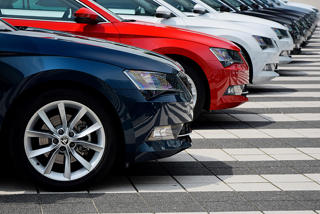Cash or car? That’s the choice continually facing thousands of company car drivers, with evidence suggesting an increasing number of people are opting for the money.
At Countryside Properties, for example, around two years ago, 40% of employees who were eligible for a company car chose to take the cash allowance.
“In October last year, we had a 50:50 split and we’ve now seen that creep more towards a 55% uptake on cash,” says Countryside Properties group facilities and fleet manager Chris Connors.
“If it was to stop now we wouldn’t be too unhappy as the 55:45 split is in no way disastrous, but, when we consider our car policy is part of our recruitment and retention tool, it is quite a worrying trend.”
Connors says this switch has coincided with numerous changes and uncertainty in the company car sector over issues such as the lack of clarity about future benefit-in-kind (BIK) tax bands – tax rates beyond the 2020/21 tax year were announced only earlier this month – as well as rising BIK bills.
Richard Hipkiss, managing director of Fleet Operations, adds: “WLTP (Worldwide harmonised Light vehicle Testing Procedure) has also come in which has seen car CO2 emission ratings increase which affects an employee’s company car tax. It has also reduced the availability of models that are cost-effective enough to sit within company car policies.
“Many P11D values have gone up, organisations are potentially lowering the price points for vehicle grades and bands, so drivers in a company car scheme may now be entitled to a lesser car.
“We have seen organisations looking to opt out, saying ‘it’s not our problem any more, drivers can go and procure their own vehicles’, and there are benefits to an employee doing that.”
Arguably the biggest benefit is it gives them flexibility to buy cars which they would not be able to get through a company car scheme.
“Do they want something nice, flashy and expensive, and fund more on top of the cash allowance to get that?” Hipkiss asks.
“Do they want something really cheap and cost-effective and keep the difference as salary, or something in between?
“However, it is their own risk acquiring, insuring and maintaining their own vehicle, as well as dealing with any other cost associated with it.
“Also, if they leave their role for any reason the vehicle is essentially stuck with them, so there is a balance that the employee needs to look at and, financially, in a like-for-like situation 90% of employees would always take the company car because of the benefits.
“It’s fully insured and maintained, you’ve got a fixed cost and potentially no risk to yourself, but obviously we are not in a like-for-like situation any more. The option for cash is becoming more appealing to drivers as well as employers.”
On the surface, giving employees cash may also appear to benefit fleet decision-makers – particularly those with other key roles to fulfil outside of fleet – as it could potentially relieve some of the burden and uncertainties of managing vehicles.
But it does come with a number of drawbacks. Shaun Sadlier, head of consultancy at Arval UK says: “An increasing number of employers have realised that simply handing over an amount of money every month to fund a car is fraught with complications.
“The important fact to realise about any arrangement of this kind is that the cash provided to the employee is for a company car replacement.
“The vehicle being used on business may not be part of the fleet, but it still needs managing to almost the same degree as any other fleet asset.
“That means, first and foremost, that you need to ensure you are fulfilling your duty of care as an employer and that all aspects of risk management concerning the vehicle are being fulfilled, from its overall suitability to its ongoing maintenance.
“Similarly, there are other issues that will be of concern, such as the environmental impact of the cars being used from a CSR (corporate social responsibility) point of view.
“There needs to be policies and processes to ensure that comparable standards to those used across the rest of your fleet are applied.
“However, carrying these measures out at arm’s length using cash for a car is not easy, as many employers have found.”
The potential to increase the grey fleet size is not necessarily a problem if work-related road risk is managed appropriately, according to Paulo Larkman, principal fleet consultant at Hitachi Capital Vehicle Solutions.
“Offering cash can lead employees of a similar grading to be driving vastly different cars and could lead to a fundamental problem about whether or not employees taking cash can be mandated to fund a certain type of car (i.e. fall under a similar policy to a company car),” he says.
Keeping drivers informed
Fleet decision-makers should be prepared to offer information to ensure employees make the right choice for their personal circumstances.
“We try to give people information when they want information,” says Connors. “We will highlight the benefits of a company car and what is included such as service and maintenance, accident management and that it, effectively, becomes our responsibility to keep people mobile.
“Giving them this information allows employees to make an informed choice about running their own vehicle.
“We try to guard against giving too much guidance and advice because we don’t want to lead the witness, so to speak. We would rather provide the information for them to make their own choice.”
Fleet decision-makers are also sometimes able to make their company car scheme more attractive to keep employees in it, such as widening the choice of brands and models available, and varying replacement cycles to give employees peace of mind over any short-term uncertainty.
“The answer to how fleet managers can encourage employees to stay in company cars will vary dependent on the company’s individual fleet – for example, whether it is a perk fleet or a mission critical fleet or whether the scheme is limited to certain manufacturers,” says Larkman.
“Although these will all differ, the first stage of finding the best way forward will be the same for all fleets which must go through a thorough diagnosis to ascertain if it is in the best possible shape to meet the company’s objectives.
“Aspects of this review will explore different manufacturers and their discount offers, car types, fuel variations and incoming new technology among many others.”
For those employees who do opt out, an employer has the ability to work with leasing companies to offer them personal finance packages which offer corporate discounts.
“We’ve yet to come across a business that says to its employees ‘we are going to give you cash and then walk away’,” says Mike Moore of Deloitte.
“What organisations tend to do is work with their current lease providers to look at solutions that aren’t a company lease.
“There is also the issue of whether you can use the corporate discounts that you currently have in personal finance packages.”
Last year’s FN50 report found that many of the country’s largest leasing companies had launched new products designed to target cash-takers and company car drivers.
All of the top 10 companies offer some type of PCH, with some companies further down the list also entering the space for the first time.
Salary sacrifice schemes can also be used to give employees access to new cars.
“Thinking in terms of cash for car is something of an outmoded way of looking at methods of alternative company car provision,” says Sadlier.
“Managing an asset owned or leased by an employee presents obvious difficulties. It can be done and we help many businesses to do so, but there are often better alternatives and the industry is very much moving in this direction.
“For example, we are seeing a definite trend towards affinity-style personal leasing schemes that are operated by us on behalf of the employer but allow the driver to choose and fund their own car.”
Hitachi is also developing funding alternatives that give employees the advantages of a company car while allowing them to fund the vehicle privately, says Larkman.
“As such, company car tax is not due. Insurance and maintenance is included and deducted from the employee to ensure a BIK charge does not arise,” he adds.
Another new market entry is ALD Automotive, whose ALDSelect digital car benefit scheme aims to provide all employees at an organisation with access to a car scheme offering manufacturer discounts, as well as allowing them to apply for credit through the website.
Mileage can be big factor when making a choice

Fleet decision-makers should be ready to provide employees with all the information they require to make an informed choice.
This includes making them aware of the benefits of a company car and the potential risks of opting for a cash allowance.
Paolo Larkman, of Hitachi Capital Vehicle Solutions, says: “The one thing that employees must do before taking the cash is to do their own due diligence.
“That is to say, not only understanding the financial costs of taking the cash, but the costs of taking the company car.
“Insurance, maintenance, tyres and breakdown cover can be accompanied by the headline rental for a lease or PCP (personal contract purchase) deal, which makes the decision of individuals procuring their own vehicle a tough one.
“The other important factors are non-financial. For example, the convenience of taking a company car, whether that is not having to trawl through endless retail deals to find the right car at the right price, but also that the company car is fully insured and maintained.”
Mike Moore, of Deloitte, says employees should also be made aware of any mileage restrictions placed on any PCP or lease agreement.
Typically, standard PCP deals will place an annual restriction of 6,000 to 10,000 miles, with an excess mileage penalty of between 2.5 and 15 pence per mile.
“If an employee moves away from a company car, that is one of the biggest issues they have to manage,” adds Moore.
“Some employees might have high private mileage profiles and if you give them cash to go out and fund their own car, that can be a lot more expensive for them than for somebody who does low private mileage.”
Richard Hipkiss, of Fleet Operations, adds: “We see huge numbers of horror stories whereby employees take a personal lease on 10,000 miles a year, but when they come to the end of the lease they’ve either got an excess mileage bill they can’t afford, or mid-lease they are looking at recontracting the vehicle and paying more than they can actually afford.”
Managing grey fleet drivers

Managing cash-takers follows the same principles as for those use their own vehicles on occasional business use.
The six steps they should follow are:
1 Measure grey fleet use. A fleet manager should establish how and why employees use their own cars for business.
2 Introduce a travel hierarchy. Once the type and length of journeys have been determined, an organisation can put in place appropriate alternatives such as trains, pool cars, car clubs or daily rental vehicles.
3 Manage vehicles. Employee-owned vehicles are often much older than company cars, and a grey fleet policy should outline the minimum standards they must meet for the following: Euro NCAP safety ratings, vehicle age, emission levels and essential breakdown cover.
4 Manage drivers. Drivers should receive the same scrutiny as employees with company-owned vehicles and provide evidence of a valid and clean driving licence, as well as details of insurance and breakdown cover.
5 Communicate. Once a grey fleet policy has been formulated, it should be communicated to employees at all levels.
6 Enforce policy. Take steps to make sure drivers comply with the policy, such as withholding mileage payments until all valid documents are produced and compliant.























Login to comment
Comments
No comments have been made yet.